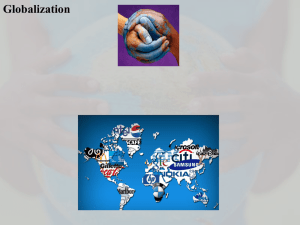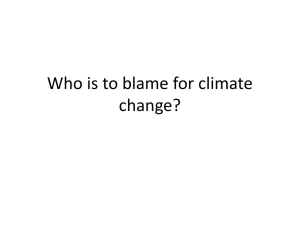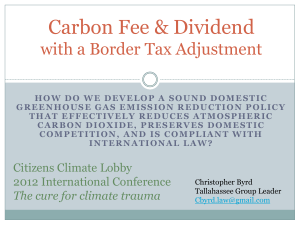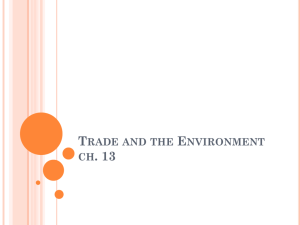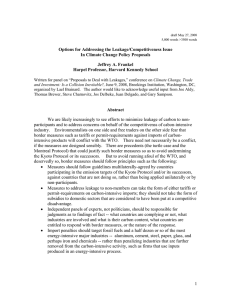Environmental Effects of International Trade
advertisement
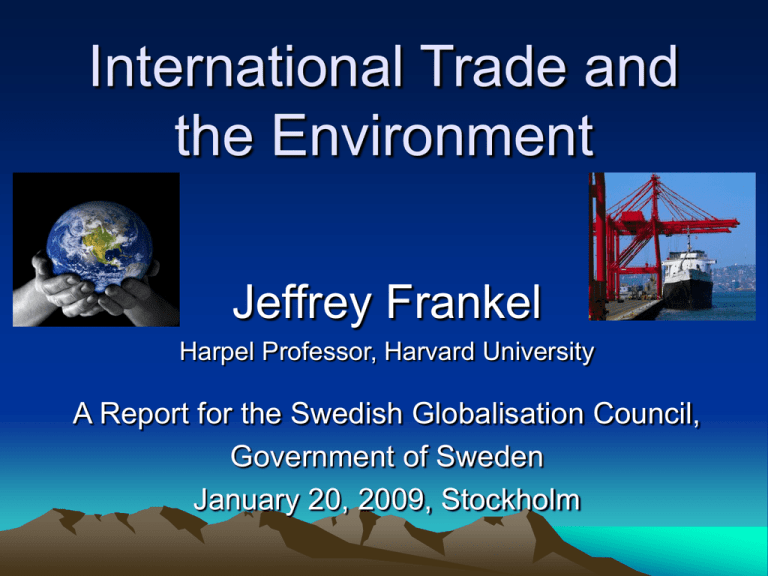
International Trade and the Environment Jeffrey Frankel Harpel Professor, Harvard University A Report for the Swedish Globalisation Council, Government of Sweden January 20, 2009, Stockholm The anti-globalization movement • Ten years ago some protestors at the Seattle WTO Ministerial meeting, launching the first of the big antiglobalization demonstrations, wore turtle costumes. • They felt that a WTO panel had, in the name of free trade, negated the ability of the US to protect sea turtles, – simultaneously undermining national sovereignty & – the international environment. Central questions • Is trade good or bad for the environment? • Does globalization help or hurt in achieving the best tradeoff between environmental and economic goals? – Do international trade & investment allow countries to achieve more economic growth for any given level of environmental quality? – Or do they damage environmental quality for any given rate of economic growth? • Do the WTO & environment conflict? • How can globalization best be harnessed? Symmetric fears • Free traders fear that talk about environmental protection will be used as an excuse by some economic sectors to gain protection for themselves against competition from abroad. • Environmentalists fear that talk about free trade will be used as an excuse to give inadequate weight to environmental goals and excessive weight to maximization of GDP. Is trade itself good or bad for the environment? • There are many possible effects of trade. • They can be categorized according to – whether they operate • via GDP, just like investment, technology, & other sources of economic growth, • or whether they are peculiar to trade alone, and hold for a given level of GDP. – Within each category, there are effects both • beneficial for the environment, • and detrimental. Is trade itself good or bad for the environment, in theory? Environmental effects of trade via growth in income: for a given level of income : Harmful effects larger scale of economic activity “Race to the bottom” in national regulation Beneficial effects shifts to cleaner techniques and composition of economic activity “Gains from trade”: ratcheting up standards, consumer power innovation, THE IMPOSSIBLE TRINITY OF GLOBAL ENVIRONMENTAL REGULATION Protectionism National sovereignty RACE TO THE BOTTOM Unregulated emissions Environmental standards Multilateral governance Globalization SO2 concentrations tend to fall with openness, especially after controlling for democracy, cross-country CO2 emissions/cap tend, if anything, to rise with openness CO2 Em issions vs. Trade Openness (ave data 1991 and 1992) CO2 Emissions per Capita 30 25 20 15 10 5 0 0 100 200 Trade Openness 300 400 But these rough correlations tell us little. • To isolate the effect of trade on a country’s environment, we need to control for other determinants, such as – income – democracy – population density. • Econometric analysis – Frankel and Rose, 2004 Is trade itself good or bad for the environment, statistically? Source: Frankel and Rose, R.Ec.& Stats., 2004 Environmental via growth in income: effects of trade (1990) for SO2 concentrations for CO2 emissions / capita for a given level of income: EKC: after an income of about $5,700/cap., further growth tends to reduce pollution (via national regulation) The favorable effects of trade seem to dominate No sign that total emissions ever turn down. (CO2 is a global externality: little regulation is possible at the national level) Trade may also increase emissions even for a given level of income Do harmful or beneficial effects of trade dominate for environmental goals? Bottom lines: • For SO2 – at low incomes, harmful effects (EKC) work against beneficial effects – at high levels of income, trade helps through both channels. • For CO2 – Even at high levels of income, trade continues to hurt. <= Absent an effective multilateral treaty, the popular will cannot be enacted. I have now updated this econometric analysis • for my Swedish Globalisation Council paper -• putting together data from 1990-2004, • for 158 countries. • EKC (inverted U) shows up for PM10 & CO2 emissions, and water pollution. • Trade still appears to worsen CO2. • Again, the obvious explanation is the lack of a comprehensive global climate agreement. We now have the Kyoto Protocol But it lacks: • Provisions for targets in future years • Targets for US, China & other developing countries • An enforcement mechanism – including an incentive for holdouts to join, and – enforcement of the agreement. – Could trade sanctions be the mechanism? Possible application of trade barriers by US climate change legislation: • The serious Climate Change bills introduced in the 110th Congress called for some border adjustment: – tax applied to fossil fuel imports or – energy-intensive imports require permits. • Washington may not realize that the US is likely to be the victim of legal sanctions before it is the wielder of them. Possible application of trade barriers by EU: Directive of the European Parliament & of the Council, Paragraph 13, amending Directive 2003/87/EC so as to improve and extend the EU greenhouse gas emissions allowance trading system; Brussels, Jan. 2008: • “Energy-intensive industries which are determined to be exposed to significant risk of carbon leakage could receive a higher amount of free allocation, or • an effective carbon equalization system could be introduced with a view to putting EU and non-EU producers on a comparable footing. Such a system could apply to importers of goods requirements similar to those applicable to installations within the EU, by requiring the surrender of allowances.” Would carbon-import penalties be compatible with the WTO? Question (1): GHG emissions are generated by so-called Processes and Production Methods (PPMs). Does that rule out trade measures against them? Question (2): What specifics of trade control design are appropriate? Precedent (1): Montreal Protocol on stratospheric ozone depletion • Trade controls had two motivations: – (1) to encourage countries to join, and – (2) if major countries had remained outside, would have minimized leakage, the migration of production of banned substances to nonparticipating countries . – In the event (1) worked, so (2) not needed. Precedent (2): The true meaning of the 1998 WTO panel shrimp-turtle decision • New ruling: environmental measures can target, not only exported products (Article XX), but also partners’ Processes & Production Methods (PPMs), • subject, as always, to non-discrimination (Articles I & III). • US was able to proceed to protect turtles, without discrimination against Asian fishermen. • Environmentalists failed to notice or consolidate the PPM precedent. Precedent (3): In case there is any doubt that Article XX, which uses the phrase “health and conservation,” applies to climate change, … • A 3rd precedent is relevant: • In 2007, a WTO Appellate Body decision regarding Brazilian restrictions on imports of retreaded tires confirmed the applicability of Article XX(b): • Rulings “accord considerable flexibility to WTO Member governments when they take trade-restrictive measures to protect life or health… [and] apply equally to … measures taken to combat global warming.” • Central message: border measures to address leakage need not necessarily violate sensible trade principles or the WTO, – but there is a great danger that they will in practice. • The danger: If each country imposes border measures in whatever way suits national politics, – they will be poorly targeted, discriminatory, and often disguisedly protectionist. – they will run afoul of the WTO, and will deserve to. • We need a multilateral regime to guide such measures. • Some subjective judgments as to principles that should guide design of border measures… Appropriate border adjustments could be tariffs or, equivalently, a requirement that importers surrender tradable permits. Guiding principles include: • Measures should follow guidelines multilaterally-agreed among countries participating in the targets of KP & its successors. • Judgments as to findings of fact (who is complying, etc.) should be made by independent expert panels. • Measures should only be applied by countries that cut their own emissions in line with the KP & its successors, against countries not doing so due to either refusal to join or failure to comply. • Import penalties should target fossil fuels, and a half dozen of the most energy-intensive major industries: aluminum, cement, steel, paper, glass, and perhaps iron & chemicals. Summary of conclusions • My report considers whether globalization has damaged environmental goals, – either among open countries in general (through a “race to the bottom” in environmental regulation) or – in certain countries (“pollution havens”). – Such effects are plausible in theory, but empirical studies of cross-country data find no detrimental effects of trade on some measures of environmental degradation such as SO2 air pollution, controlling for income. Summary of conclusions, continued • Thus globalization and the environment need not necessarily be in conflict. – Trade & growth give countries the means to clean the air, • provided they have effective institutions of governance in place. • For local air pollution, the appropriate governance is at the national level. Summary of conclusions, continued • But the evidence does suggest that trade & growth can exacerbate other measures of environmental degradation, particularly CO2 emissions. • The difference can be explained by the observation that CO2 is a global externality – which cannot be addressed at the national level due to the free rider problem. – We need institutions of governance at the multilateral level. – These have not been in place, at least until recently. The solution • Greater international cooperation on environmental and trade issues, • so that we can get the best of both. • Very specifically, the Copenhagen Conference of Parties should negotiate guidelines for penalties on carbonintensive imports that countries are allowed to impose on each other. The author acknowledges • capable research assistance by Danxia Xie; • valuable input from Joseph Aldy, Scott Barrett, Jagdish Bhagwati, Thomas Brewer, Steve Charnovitz, Arik Levinsohn, Gary Sampson and Robert Stavins; • useful comments on the first draft from Pontus Braunerhjelm, Prasanth Regy, Rob Stavins, Helena Svaleryd, and Danxia Xie; • and support from – a Faculty Grant in Sustainability Science from Harvard’s Center for Intenational Development, – as well as from the Government of Sweden. Appendices • WTO – Seattle demonstrators – Language regarding environment – Panels • Characteristics of carbonintensive import penalties WTO protests. Why did they march together in Seattle? Category of Claimed demonconstistrator tuency Protestor in Environ turtle costume ment True position of constituency In favor of the Kyoto Protocol Labor union official Organized Against the Kyoto protocol; in labor favor of keeping out cheap imports from poor countries NGO volunteer Poor countries In favor of selling their goods to rich countries; in favor of Kyoto protocol if it exempts them from commitments. Mutual respect • Drafters in Kyoto and Geneva showed more consideration for each other than the rank & file of environmentalists and free traders. • The Kyoto Protocol text: – Parties should “strive to implement policies and measures...to minimize adverse effects on international trade...” ; – FCCC features similar language • WTO regime is equally solicitous of the environment: – Article XX allows exceptions for health & conservation – Preamble to 1995 Marrakesh Agreement establishing WTO seeks “to protect and preserve the environment;” – 2001 Doha Communique starting new round of negotiations: “the aims of ... open and non-discriminatory trading system, and acting for the protection of the environment ... must be mutually supportive.”. Typical WTO panel cases • Tariffs or other measures that discriminate against producers in some trading partners, – either in favor of other trading partners (potential violation of MFN principle of Article I) or – in favor of “like products” from domestic producers (potential violation of national treatment provision of Article III). • If targeted country files a WTO complaint alleging such a violation, the question is whether the measure is permissible under Article XX – which allows for exceptions to the non-discrimination principles for environmental reasons (XXb), – provided that the measures in question are not “a means of arbitrary or unjustifiable discrimination” or a “disguised restriction on international trade.” I classify characteristics of possible border measures into 3 categories, named by color: (1) “White” category: those that seem reasonable & appropriate. (2) “Black” category: those that seem dangerous, in that they are likely to become an excuse for protectionism. (3) “Grey” category: those that fall in between. French President Sarkozy: • “…if large economies of the world do not engage in binding commitments to reduce emissions, European industry will have incentives to relocate to such countries…The introduction of a parallel mechanism for border compensation against imports from countries that refuse to commit to binding reductions therefore appears essential, – whether in the form of a tax adjustment or – an obligation to buy permits by importers. • This mechanism is in any case necessary in order to induce those countries to agree on such a commitment.” letter to Barroso, January 2008 Black (inappropriate) border measures include: • Unilateral measures applied by countries that are not participating in the Kyoto Protocol or its successors. • Judgments as to findings of fact made by politicians, vulnerable to pressure from interest groups for protection. • Unilateral measures to sanction an entire country. • Import barriers against products that are removed from the carbon-intensive activity, such as firms that use inputs that are produced in an energy-intensive process. • Subsidies -- whether in the form of money or extra permit allocations -- to domestic sectors that are considered to have been put at a competitive disadvantage. The Gray (intermediate) measures include: • Unilateral measures that are applied in the interim before there has been time for multilateral negotiation over a set of guidelines for border measures. The import penalties might follow the form of existing legislation on countervailing duties (CVDs).
